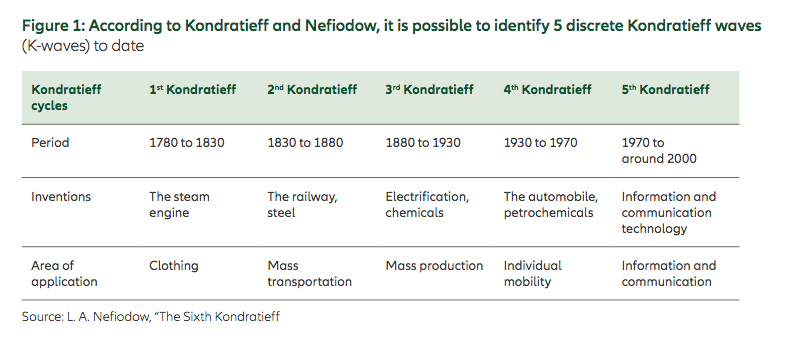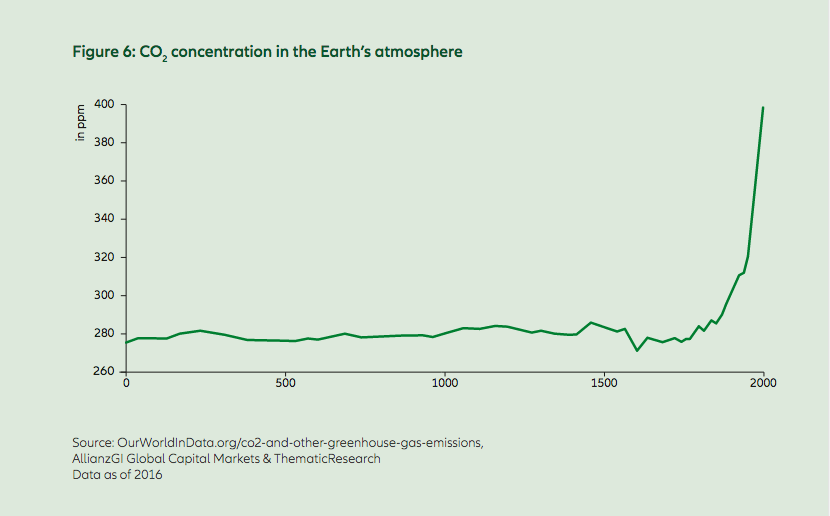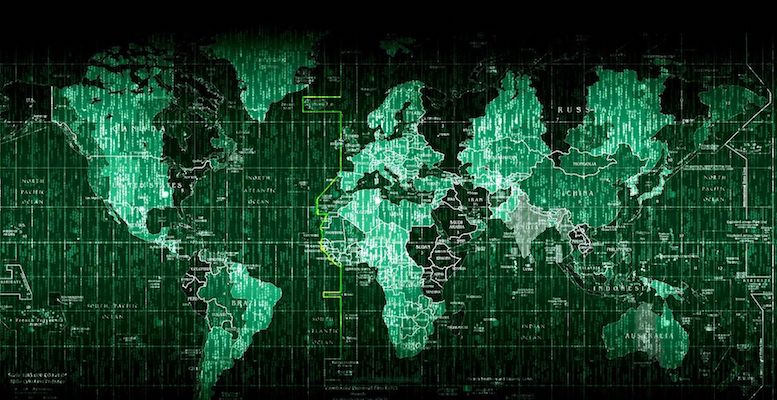Hans-Jörg Naumer (Allianz Global Investments) | According to the Russian economist Kondratieff and his scholars, it is possible to identify five long cycles of growth since the Industrial Revolution at the end of the 18th century: the first wave was triggered by the advent of the steam engine, which was followed by steel and the railway as new technologies. These were later to be supplanted by the development of chemicals and electrification, before the petrochemical and automotive sectors asserted themselves. The final wave of growth was dominated by information technology and communication.
The interesting aspect of this is that all these new waves of growth were interrupted by crises before giving rise to the next new boom. Examples of these include the panic of 1837, the entrepreneurial crisis of the late 19th century, the Great Depression of the 1930s and the two oil crises of the 1970s. “Creative destruction”, as the Austrian economist Joseph Schumpeter put it, always preceded the start of something new.
These long cycles of growth, which were first described and studied by Nikolai Kondratieff, have recently been researched by Leo A. Nefiodow and Erik Händeler, in particular.
Kondratieff waves mark times of technological upheaval extending over long periods of growth spanning 40 to 60 years, before finally collapsing into a dramatic downturn, which in turn gives way to a new wave of prosperity. Altogether, there are five characteristic features that herald a trend reversal towards a new Kondratieff cycle.

From megatrends to the 6th Kondratieff wave
In the same way as previous Kondratieff waves, the sixth wave will also be driven by scarcity factors that will enable basic innovations to flourish. The following megatrends, which are still evolving and will determine these scarcity factors, play a decisive role.
1. Demographic trends: the world’s population is ageing and will continue to grow, albeit at a dwindling pace.
2. A growing depletion of the “environment” factor – with a focus on climate change – demands a global effort to reconcile ecological and economic interests. Humanity is still living beyond its means, as demonstrated by the rate of biocapacity loss and the CO2footprint. We need to make a transition from parasitic to symbiotic growth if we are to meet the demands of the planet’s next generation of inhabitants for a good quality of life.
3. Digitisation: This is reflected in the increasing penetration of robots and artificial intelligence in manufacturing processes as well as every-day life.
According to United Nations estimates, the global population will rise from a present level of around 7.5 billion to 10 billion by 2050. By 2100, it is expected to have reached 11 billion inhabitants. More and more people who will be living longer and longer. While the rates of population growth continue to slow down, human beings are living to an older age.
On the other hand, calculations by the Global Footprint Network show that mankind’s ecological footprint has exceeded the volume of additional bio-capacity made available each year since the early 1970s. In other words, we have long since been running an ecological deficit by living far beyond our means. We currently consume 1.7 times the biocapacity that the Earth provides us with and this trend is accelerating.
Despite the Paris Agreement of 2015, carbon dioxide emissions have continued to rise as if nothing had happened. In its “business as usual” scenario, the Intergovernmental Panel on Climate Change (IPCC) predicts that the world will heat up by 3 to 5 °C by 210016 (see next figure). This global heating is bound to have a major impact on economic growth. Marshall Burke et al. expect global economic output to fall by around 25 % by 2100.17 The climate and the environment will be “disrupted”.

The third megatrend that will drive developments in the long term is digitisation, coupled with artificial intelligence (AI). AI will play a pivotal role in the transition to #GreenGrowth – an ecologically sustainable economy.
As a conclusion, the environment itself has become a scarce commodity. It can no longer be consumed for free – this should never have happened anyway. Climate change is the final, incontrovertible wake-up call for this ecological reality. The resulting pressure to take action will transform practically every facet of the economy and lead to a new phase of growth.
This kind of growth will be different than in the past. Transitioning to renewable energy, in particular, shows that growth will be less about consuming and more about regenerating available resources. The keyword here is sustainability.
Looking even further beyond the horizon, when we consider the planet we live on – Earth – growth will evolve from being parasitic to symbiotic. The basic technologies for this transformation (specifically artificial intelligence as a driver), just as Kondratieff would have called for, are largely already available. The focus will be on #GreenGrowth. The next Kondratieff wave will be green and it has already begun.





